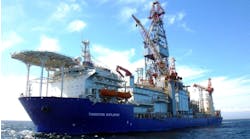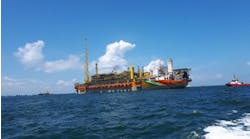Piston saver ring limits cylinder wear and lube consumption
Scania's saver ring prevents coke build-up and reduces engine wear.
A small but unique addition to every Scania engine that was introduced in 1988 has confirmed its value as a major benefit to performance and economy. The saver ring now sits at the top of each cylinder liner in every Scania industrial and marine engine where it efficiently scrapes away any coke buildup within the bore.
The ring is combined with a top piston ring of the Keystone type, so that every time the piston passes the edge of the ring, any coke is removed. After 12 years in service on over 50,000 Scania engines in use around the world, this device is now being credited as the principal reason behind the company not having experienced a single engine seizure since its introduction.
The advantage of the saver ring is that the continuous removal of coke results in a major reduction in cylinder liner wear. This, in turn, reduces consumption of lube oil, as none is sucked up into the cylinder and burned, where it would generate particulate pollution. It helps to increase engine life while reducing lube oil consumption to less than 0.3 g/kWh, a figure which Scania claims is unmatched by any other manufacturer.
Explaining the success of the saver ring, Lennart Hjelte, senior vice president and head of industrial and marine engines for Scania, said; "In any application where you have to run the engine hard, the ring saver will be of special benefit. Coke buildup in the piston crown is a universal problem as it leads to the risk of bore polishing in the cylinder liner. We don't see that problem any more. It also reduces particles in the exhaust, because the engine does not burn any lube oil, which saves costs. It appears to be a rather simple solution, but the idea is ingenious - and these are often the best."
As an illustration of the hard life to which Scania engines can be subjected, the marketing team, based at the company's headquarters in S
Scania now manufactures variations of nine engines in the 250-675 hp range for marine and industrial applications and three engine families for powering generator units with a range of 150-400 kVa. A double-acting cooling system is also available which cools the water twice to lower the temperature of the charge air and to avoid seawater getting deeper into the engine than the heat exchanger. This has the benefit of reducing any likelihood of corrosion, which is demonstrated by the fact that very few anodes are needed to protect the system.
The newest addition to the Scania range is a 12-liter marine diesel engine that is claimed to be the most compact unit of its type on the market. Introduced in 1998, the Scania D12 is available in a range of power outputs appropriate to the intended application. For workboats, the D12 can be used to produce 360-500 HP, while larger patrol craft can be equipped with 575-625 HP versions.
The D12 is a charge-cooled in-line six- cylinder diesel engine with a high power-to-weight ratio. To maintain a consistent fuel-air mixture and improve fuel consumption and emission control, all Scania diesels are designed so that the cold inlet/injection side of the engine is thermally separated from the hot exhaust side. The camshaft is placed high on the engine block to reduce the length of the push rods and is the optimum position for future fuel systems and emission control strategies.
Each cylinder has four valves as well as its own individual cylinder head. This not only makes them structurally very strong but also very light and enables servicing and repair on board easy for just one person to carry out.
One-person service
The Humid Air Motor has been developed by researchers at Scania and the University of Lulea. The modified diesel retains its performance but reduces NOx emissions.
The capability for Scania engines to be serviced by just one person is an important part of the company's design strategy. The company recognizes that its products are sometimes likely to be installed in confined spaces where only one engineer can work on them. The separate cylinder heads, for example, allow for easier and quicker service repairs without workshop facilities. This is now acknowledged as a more realistic approach than that taken by those manufacturers who build engines with a single cylinder head that might weigh as much as 200 kg.
Engine and charge-air cooling are handled by the twin-circuit heat exchanger and the tubular charge-air cooler that was described earlier. This helps to improve the charge cooling at full load as the water is cooled twice. In addition to preventing seawater from entering the engine, it enables intake air to be automatically preheated at extended idling or when operating in cold water.
Measuring just under 1 meter high and weighing 1,150 kg, the D12 is the most compact engine of its type on the market and this significantly increases the range of applications for which it could be appropriate. By designing the crankshaft pulley to also act as a crankshaft vibration damper, Scania engineers have been able to reduce the overall length of the engine. The timing gears for the camshaft and injection pump are mounted at the flywheel end of the engine from where they are able to ensure more precise drive and quieter operation with less torsional vibration.
An important feature of all Scania engines and a major contributor to their longevity is the double acting oil cleaning system. This combines a centrifugal cleaner with a paper element filter. The small particles of carbon that build up between oil changes and which would normally pass through a paper filter, are removed by the centrifuge, while the full flow paper filter removes the remaining larger particles. Scania claims that after only a few hours of operation, the process cleans nearly 100% of the oil through continuous treatment, which compares very favorably with the 80% efficiency that is achieved after 24 hours of running with engine designs using paper filters.
Fighting pollution
The new 12-liter diesel engine from Scania is claimed to be the most compact power unit in its class.
The research teams at Scania are maintaining a continuous process of engine improvement as they develop the next generation of low emission propulsion units. Currently under trial is their Humid Air Motor (HAM) system developed and tested in cooperation with Munters, which is claimed to have reduced NOx emissions by 70%.
Tests in association with, among others, the University of Lulea, show that low emissions are being achieved with a design that mixes water vapor with the intake air to give 100% humidity within the cylinder. This has the effect of reducing ignition temperature which, in turn, gives a dramatic reduction in NOx that is otherwise caused by the interaction of heat, pressure and nitrogen.
The technique has no effect upon the engine's performance and requires only minor additional modifications but is thought to hold promise as a valuable development for users of marine engines in ports where fees are levied according to pollution output. The HAM system can be applied to engines of any size. It is currently being tested on two pilot boats, a coastguard environmental ship in Sweden and on a large ferry operating between Sweden and Finland.
For more information contact Hans Hellsten, Scania, Tel: +46 8 553 818 02, Fax: +46 8 553 829 93, Email: [email protected]


